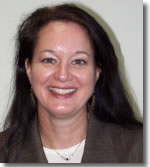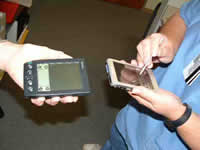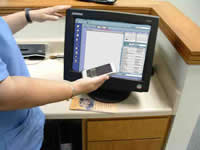 |
|
|
Integrating PDA use into your Clinical Research Site Healthcare and technology have been partners for decades, but sometimes it is difficult to bring in new technology that hasn't been developed solely for medical use. Technophobia seems to be a normal condition in nursing. Integrating Personal Digital Assistant technology into clinical research can initially seem daunting to those who are unfamiliar with PDAs. The Clinical trial industry has just begun to use web based data collection so the clinical research team may just now be getting comfortable with the use of the personal computer. The leap is not as painful as it may appear and taking the first step and learning to use the available technology will give the user an unpaid "assistant" who can become an invaluable part of the research team. A desperate need can be the catalyst of utilization of PDA's into the clinical research arena and finding new ways of utilizing a device that was not specifically designed for healthcare. I found that 24 hours was not enough hours in the day to accomplish the many tasks that I acquired when I joined a new research group. There were too many tasks, appointments, and too many places I needed to be each day that it became overwhelming. Nursing had taught me to multitask and how to prioritize, but previously I had had support staff to assist in organizing and keeping up with the multitude of projects. Here is the story of how we implemented the use of PDAs to assist research coordinators in the multiple projects involved at a private research site, and how we utilized PDAs to transfer information and keep physicians up to date and informed about the current and ongoing research projects. In November 2000, the large cardiology group where I currently work elected to pull studies that had been outsourced to a site management organization (SMO) back into the domain of the practice. The formation of an internal office of clinical research was completed in a very short time period and necessitated quick hiring and fast assessment and transfer of multiple ongoing clinical trials. The ongoing studies were quickly allocated to the four newly hired staff members in two clinical offices. In the midst of cleaning up and assuming ongoing studies, the start up of new studies provided major time management challenges. Only two staff members had practical experience in running trials independently, the remaining staff had no research experience….ever. The staff was distributed to two of the three research sites. The third site was visited on an as need basis; only when patients were scheduled. Inexperienced staff, new processes, dealing with new facilities and developing a new business within a business were just a few of the problems. The biggest challenge was keeping over 20 physicians informed of the variety of clinical trials that were open and the inclusion criteria required for patient referral, not to mention keeping non-research clinical staff informed of study openings and closings. Several of the physicians had privately purchased Palm powered handhelds that they used routinely and requested that we find a way to put study information onto the handheld. They knew that having access to this information on their PDAs would be more useful than the traditional method of carrying a stack of laminated index cards. This put us on a web-quest to figure out how to accommodate this request. At that time there was not much available information. Meanwhile, in one of our study locations, I and another RN were the only full time coordinators conducting studies. Two of the studies being conducted were hospital-based which meant that I spent a great deal of my workday in the hospital and out of the office; out of contact with the appointment book, calendar, and unable to read E-mail until much later in the day, if at all. As a result I often found that I had failed to remember a follow up appointment and would be prepping for the visit at the very last minute or late the night prior which is not a very efficient way to operate. One weekend, after a very busy and hectic week, I woke up in a panic trying to remember if I had all of my patients scheduled correctly. I realized that as a coordinator I too could benefit from using a PDA to keep up with everything. After several sleepless hours, I went to my home PC, and started surfing for PDAs, one that I could afford and that had enough memory to allow me to integrate my personal appointments and data with my professional needs. I found a website that listed comparisons of the available PDAs. I found what I felt would fit my needs and started searching on the web for best prices. I found the best price and in a 3 AM sleep deprived haze I whipped out my credit card and placed the order. Three days later I was holding the new tool that was going to help me organize my life- the PDA. The following two weeks I spent learning the ins and outs of the device by trial and error. I started at home with simple functions first, the address book, then the calendar functions. I mastered loading the data onto my computer at home and syncing to the PDA. Then I took it a step beyond and loaded data from my PDA onto my work computer. This necessitated an additional cradle, but what a great way to transfer information from one place to another and no paper. I now had both work and home calendars integrated. I then focused on finding software designed to transmit text documents from PC to PDA. I found a freeware piece of software and started the process of trial and error to load the data onto my PDA. I was then able to beam the information to other staff, but I found the freeware application unreliable.
We began putting inclusion and exclusion criteria on the PDAs for coordinators and physicians. We purchased software that allowed text and spreadsheet documents to be loaded on the PDAs. We are able to load visit calculators for the particular protocol. This has been most advantageous to the coordinators who spend a great deal of time in the hospital and often have no access to their appointment book or to a calendar. Patients have a better idea of what to expect in follow up, and coordinators are not left to "guess" at the next visit window. The spreadsheet format we use allows the coordinator to enter the enrollment or randomization date and the spreadsheet does the rest of the calculations. The coordinator can save the document with customized information for the subject and download it or view it later. We still have to design the document on the PC, but it doesn't mean that the PC has to be immediately available. Getting this information to the physician and investigators PDAs was just a beam away and took less time than detailing the study to a physician who was already late for clinic or hospital rounds. It became a less aggressive way to get physicians to talk about the new studies. Most of the physicians are interested in the newest and latest electronic devices, so using the PDA was a non threatening method of information transmission. During the course of the year the practice converted to the use of Palm handhelds for the rest of the physicians and the possibility of "available" equipment struck us as an opportunity to be seized. As some of the physicians handhelds were upgraded or discarded, the Research Department begged for these PDAs for the study coordinators. Most were Palms with little or no expansion capability. The maximum internal memory on these devices was 16 megabytes (But there is a new device, the Palm Tungsten C which has a whopping 64 MB of internal memory). This allowed the placement of inclusion criteria as well as protocol synopsis and some visit scheduling programs for individual studies onto the PDAs and allowed the coordinators to lighten the amount of paper and notebooks that clutter space and become mangled after just a couple of days. Being in two places at one time is part of the daily routine for a study coordinator. Having a PDA can eliminate the hassles of carrying loads of file folders for the purpose of screening patients for potential enrollment into studies. Accessing the stored documents on the PDA was and is as simple as tapping the screen with the stylus. If the coordinator needs to share inclusion criteria or update a current project, it takes only a few seconds to beam the new information, and there is no transfer of paper. If there is a need to know how to contact the medical monitor for a study question that has to be answered quickly, it can be as easy as accessing the address on the PDA. Slowly but surely all study coordinators in our department had a PDA in their pocket, some provided by the MDs as they upgraded to newer gadgets and some already owned by our growing number of staff members, many of whom saw the benefit of owning their own PDA to allow them to integrate personal information and have more memory for personal as well as work items. Our current status of no memory expansion does not allow the use of the PDA for downloading e-mail for reading or reply, since the bulk of the memory is used by a few date book items and lots of text documents and excel files for the current projects. There is definitely a need to upgrade the current devices we use, and we are looking at options that might be available.
ePocrates, a drug reference software that is free to health professionals, has been a time and pocket saver too. Generic and trade name medications are listed with indications, pediatric and adult dosages, side effects, contraindications, and general cost information. Drugs are classified by type and listed alphabetically for easier reference. The information is updated at each synchronization, and the program has the added benefit of giving opportunities to learn more about disease process, drug interactions, and drug alerts and updates with the synchronization process. MedRules and MedCalc are two freeware programs that offer information for the PDA medical user. The MedCalc application allows calculation of various pre-determined drugs such as sedation. MedRules is as it states, a list of medical pearls -do's and don'ts for the practice of medicine. We also use the STAT Cardiac Risk application to assist in determining if a patient meets the criteria for a particular study that requires risk factors and a Framingham assessment. It's been three years now, and we still learn new things about using the PDA's in research. One of the unexpected things I learned is that our busy Information Systems department has too many projects on the go so we tend to look after our PDAs ourselves. I guess I can now add "IT Specialist" to my job description. I am now the designated person for the PDA installation and maintenance. Sounds difficult, but sometimes it is no more difficult than surfing the a PDA website or joining a PDA listserv and asking a question or two. I've learned that most of the problems we encountered have been experienced by someone else, and often a visit to a PDA website helps me solve the problem. There is a learning curve, as with any new technology, but most coordinators are adapting quickly to a tool that can be so valuable. The technophobia that seems to run in the healthcare field is dissolving. Personal computers are a daily part of routine in most facilities. New nurses are graduating from schools and classrooms where computers were the norm. Soon we'll all be using the PDA with ease and it will be a familiar piece of the coordinator equipment. Software is being developed to make using the handheld devices even more seamless in at the clinical trial site. It will be great when all those case report forms can be completed with check boxes on the PDA as you perform your clinical visit, and then downloaded to the sponsor via a wireless transmission or synchronization to your PC. I am enthusiastically awaiting the day when the pharmaceutical
industry and clinical trial sites advance to the stage where electronic
data capture and transmission become the norm. Donna can be reached via email
|
|||||||||||||



